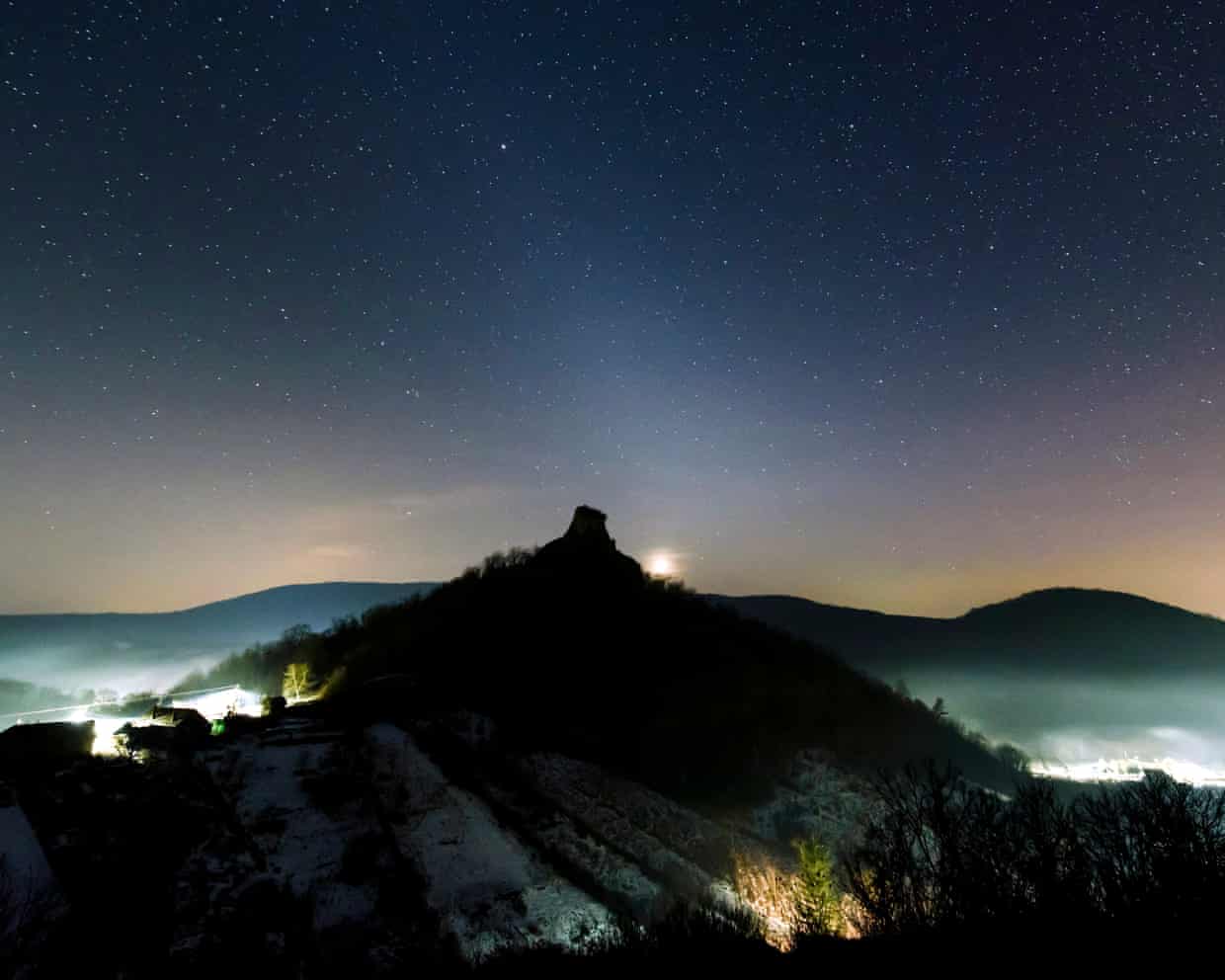Science
Skywatchers Set to Observe Stunning Zodiacal Light This Week

Skywatchers around the world have the opportunity to witness the ethereal phenomenon known as zodiacal light this week. This soft glow, visible in the night sky, is created by sunlight scattering off interplanetary dust that resides in the plane of our solar system. The dust originates from comets and collisions between asteroids, giving rise to this delicate celestial display.
Understanding Zodiacal Light and Its Timing
The zodiacal light manifests as a faint, triangular luminescence that stretches from the horizon. Its visibility peaks around the equinox period, which recently occurred on March 20, 2024. During this time, the plane of the solar system, referred to as the ecliptic, rises steeply from the western horizon, making it an ideal moment for observation.
For those in the Northern Hemisphere, the best viewing conditions are found in dark locations with a clear view of the eastern horizon. Observers should plan to begin their stargazing approximately one hour before dawn twilight starts, which translates to around 04:00 GMT. To locate the zodiacal light, focus on the constellations of Leo and Cancer, where this gentle glow is most prominent. Its appearance resembles the dawn but can be distinguished by its wedge-like shape.
Conversely, individuals situated in the Southern Hemisphere can catch sight of the zodiacal light about an hour after sunset, extending from the western horizon. In this region, the glow will rise through the constellations of Virgo and Libra, creating a striking visual against the evening sky.
Preparation for Viewing
To enhance the experience of observing zodiacal light, it is essential to choose the darkest possible site. Urban areas with significant light pollution may hinder visibility, so selecting a remote location is recommended. Bringing along a comfortable chair and warm clothing can make the wait for dawn or dusk more enjoyable.
The interplay of sunlight and interplanetary dust creates a stunning and subtle display that many may miss without proper guidance. As skywatchers prepare to engage with this celestial event, it serves as a reminder of the wonders present in our solar system, waiting to be explored.
-

 Education3 months ago
Education3 months agoBrandon University’s Failed $5 Million Project Sparks Oversight Review
-

 Science4 months ago
Science4 months agoMicrosoft Confirms U.S. Law Overrules Canadian Data Sovereignty
-

 Lifestyle3 months ago
Lifestyle3 months agoWinnipeg Celebrates Culinary Creativity During Le Burger Week 2025
-

 Health4 months ago
Health4 months agoMontreal’s Groupe Marcelle Leads Canadian Cosmetic Industry Growth
-

 Science4 months ago
Science4 months agoTech Innovator Amandipp Singh Transforms Hiring for Disabled
-

 Technology4 months ago
Technology4 months agoDragon Ball: Sparking! Zero Launching on Switch and Switch 2 This November
-

 Education4 months ago
Education4 months agoRed River College Launches New Programs to Address Industry Needs
-

 Technology4 months ago
Technology4 months agoGoogle Pixel 10 Pro Fold Specs Unveiled Ahead of Launch
-

 Business3 months ago
Business3 months agoRocket Lab Reports Strong Q2 2025 Revenue Growth and Future Plans
-

 Technology2 months ago
Technology2 months agoDiscord Faces Serious Security Breach Affecting Millions
-

 Education4 months ago
Education4 months agoAlberta Teachers’ Strike: Potential Impacts on Students and Families
-

 Education4 months ago
Education4 months agoNew SĆIȺNEW̱ SṮEȽIṮḴEȽ Elementary Opens in Langford for 2025/2026 Year
-

 Science4 months ago
Science4 months agoChina’s Wukong Spacesuit Sets New Standard for AI in Space
-

 Business4 months ago
Business4 months agoBNA Brewing to Open New Bowling Alley in Downtown Penticton
-

 Business4 months ago
Business4 months agoNew Estimates Reveal ChatGPT-5 Energy Use Could Soar
-

 Technology4 months ago
Technology4 months agoWorld of Warcraft Players Buzz Over 19-Quest Bee Challenge
-

 Business4 months ago
Business4 months agoDawson City Residents Rally Around Buy Canadian Movement
-

 Technology2 months ago
Technology2 months agoHuawei MatePad 12X Redefines Tablet Experience for Professionals
-

 Technology4 months ago
Technology4 months agoFuture Entertainment Launches DDoD with Gameplay Trailer Showcase
-

 Top Stories3 months ago
Top Stories3 months agoBlue Jays Shift José Berríos to Bullpen Ahead of Playoffs
-

 Technology4 months ago
Technology4 months agoGlobal Launch of Ragnarok M: Classic Set for September 3, 2025
-

 Technology4 months ago
Technology4 months agoInnovative 140W GaN Travel Adapter Combines Power and Convenience
-

 Science4 months ago
Science4 months agoXi Labs Innovates with New AI Operating System Set for 2025 Launch
-

 Technology4 months ago
Technology4 months agoNew IDR01 Smart Ring Offers Advanced Sports Tracking for $169









